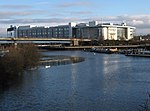Doncaster

Doncaster ( DONK-ə-stər, DONK-ast-ər) is a city in South Yorkshire, England. Named after the River Don, it is the administrative centre of the larger City of Doncaster, and is the second largest settlement in South Yorkshire after Sheffield. Noted for its horse racing and railway history, it is situated in the Don Valley on the western edge of the Humberhead Levels and east of the Pennines. The urban subdivision had a population of 113,566 at the 2021 census, whilst the City of Doncaster metropolitan borough had a population of 308,106.The city's suburbs include Armthorpe, Bessacarr, Sprotbrough among others. Adjacent to Doncaster to its east is the Isle of Axholme in Lincolnshire, which contains the towns of Haxey, Epworth and Crowle, and directly south is Harworth Bircotes in Nottinghamshire. Also, within the city's vicinity are Barnsley, Wakefield, Pontefract, Selby, Goole, Scunthorpe, Gainsborough, Retford, Worksop and Rotherham, to which Doncaster is linked by road and rail. As part of the Platinum Jubilee Civic Honours, Doncaster received city status by Letters Patent. A ceremony to confer city status took place at Mansion House on 9 November 2022 as part of a tour of Yorkshire by King Charles III and Queen Camilla.
Excerpt from the Wikipedia article Doncaster (License: CC BY-SA 3.0, Authors, Images).Doncaster
High Street, Doncaster Hyde Park
Geographical coordinates (GPS) Address Nearby Places Show on map
Geographical coordinates (GPS)
| Latitude | Longitude |
|---|---|
| N 53.52312 ° | E -1.1339 ° |
Address
Subway
High Street 44
DN1 1DE Doncaster, Hyde Park
England, United Kingdom
Open on Google Maps








